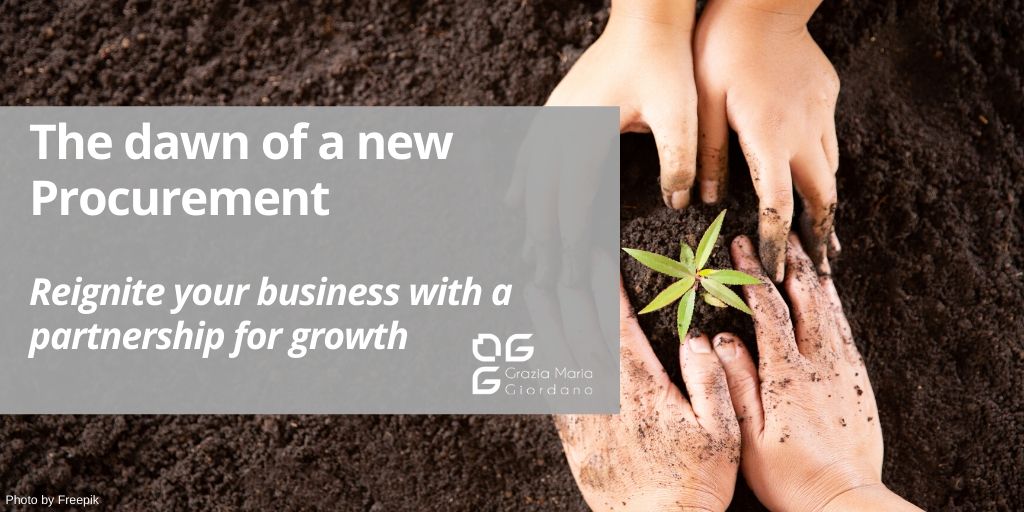Those who work in the world of Procurement have or have had a particular supplier. That Supplier with whom you can talk about everything, who supports you and advises you when you‘re out of your depth and who builds with you (the Client) the best solution for a problem.
These suppliers have a face: it is the face of the Account Manager that smiles at you when you enter the meeting room and on the phone is the first to ask how are you and share a laugh over a cup of coffee.
But it’s not just the skill or friendliness of the Account Manager that makes the difference. It is also that particular alchemy that is created with the Company (with a capital C) behind the Account Manager and in the coordinated work carried out to create the best experience for you Customer!
These are the relationships that, without any doubt, I define as “Partnership for growth”.
The suppliers involved in a Partnership for growth are not necessarily the biggest or the leaders in their market. Nonetheless, they have a privileged position, almost an elite one, at the top of the Supply Chain pyramid and although few, they play a crucial role in the growth and development of the business.
In the increasingly interconnected world in which we live (and the pandemic we are living in proves it more and more) it is essential for the success of each company to draw on the skills, competences, and ideas of others to be able to keep up with fast change.
The era of competition gives way to the age of collaboration; in fact, I prefer to say “co-creation.”
Building a Partnership for growth is not only a matter of goods and services provided to a client, but it also is not only a matter of contracts and remuneration.
It is increasingly clear to me that the success of a partnership for growth always depends on two people, a client and a supplier, facing each other.
Becoming partners takes time and is the result of long work and intentional effort from both sides of the relationship.
Looking through the designer’s eyes at the virtuous cases that I encountered in my experience, I identified a series of elements that help build a relationship which can lead to a Partnership for growth.
The first founding element of a successful Partnership for growth is the
Mutual knowledge
The mutual knowledge goes beyond the mere needs of the business. It embraces the motivations and goals not only of the companies but also of the people who in the daily life interact to make this relationship work.
Improving specific knowledge means knowing the client’s organization; who are the corporate counterparts, what are the professional and personal goals? It is intended to give the other party time and space; it means to be flexible and patient.
We should never forget that what a person is doesn’t stop at the office door, but we carry it with us in our daily work. Understanding these aspects is, therefore, crucial to growing in the relationship.
The second founding element of a successful Partnership for growth is the
Language
It is well known that the corporate world is a “huge factory” of abbreviations, acronyms and, in general of jargon specific to each company which is most of the time incomprehensible to those outside that environment. Bridging the language gap between the two sides is a fundamental step if you want to grow the collaboration.
From the Supplier’s point of view, this means learning the customer’s language and learning about the corporate culture and corporate values.
Speaking your client’s language means saying to him: I understand you! I have your back!
Knowledge and language are the two basic building blocks for generating empathy between the two sides.
Empathy means putting yourself in the other person’s shoes, seeing something through the eyes of your interlocutor. And there is only one way to create empathy: Asking!
Learning to ask questions, and opening up when answering (empathy should be a two-way feeling), puts people on the optimal path towards a successful partnership.
Empathy is essential to be able to proceed to the next step in building a Partnership for growth that of
Relevance
The empathy suppliers and client create, through growth in knowledge and common language, opens the way to a complete understanding of the situation and, therefore, allows you to design solutions that best adapt to the needs of the purchasing company. The offers become thus relevant for the client.
Being relevant in this type of relationship means promptly meeting the needs of the other party; sometimes it means giving up an easy sale in the short term because what you are offering does not satisfy the needs of the other party. Being relevant also means working with other Suppliers of your Customer always to provide what is needed, even if these other Suppliers are your competitors.
Being relevant means having a long-term perspective with a win-win approach in which the needs of both parties are met.
So far, so good, but the relationship between two people can be complicated beyond measure. In my experience, two factors can intervene to complicate a Partnership for growth.
Complexity
When two companies meet, their internal complexities can play a fundamental role in the success of the collaboration. Long and complicated procedures, problems that cannot be solved due to internal Byzantine processes, and last but not least, fragmented and incomplete communication, generate enormous difficulties in the relationship between Clients and Suppliers, even those best conceived.
In my view, strengthened by years of work as a designer, the client must be “protected” from complexity, for the Client the path must be as simple as possible and lead to the solution quickly and effortlessly.
This can also mean redesigning your internal processes to make them simple to use.
The second element that can intervene to complicate a Partnership for growth is the
Transparency (or rather the absence of Transparency!)
For me, Transparency is not only about revealing everything in every situation but also about declaring if there is something that cannot be shared and disclosed. Any tension in the relationship (the proverbial “Elephant in the room”) must be recognized if only to put it aside and be able to move forward.
In a partnership relationship, Transparency means declaring that some information cannot be disclosed and that there are areas protected by confidentiality. If done in good faith and mutual respect, such situations will not stand in the way of the partners in the relationship.
Summarizing what has been said up to this point: knowledge and common language help to generate empathy between the parts of a partnership relationship. Empathy allows the Supplier to be relevant in its relationship with the Client and therefore, to better meet the Customer’s needs. Reduction of complexity and a fully transparent relationship strengthen the relationship and lead to what is the holy grail of any partnership relationship, the
Trust
In a successful partnership for growth, trust is simultaneously the arrival point and a new starting point. It is the point of arrival because only by respecting the steps listed above can you build it, with the commitment of both parties.
It is a starting point because when there is trust, the relationship can grow and develop. Trust is fleeting, and maintaining a relationship of trust between suppliers and customers requires significant work from everyone.
It is necessary that the promises made are kept and that the services are delivered flawlessly. If something happens to risk straining the relationship, this must be fixed promptly and with customer satisfaction.
Knowledge, language, relevance, complexity, Transparency and trust these are the building blocks of an approach to Procurement with people at the centre!
Dear CPO, having stuck with me so far, I invite you to take another step forward.
Try to imagine that you are the Supplier!!
In reality, there is no need to imagine, Procurement is a Supplier, and its Clients are the other functions and departments in the company. And what said above regarding the relations between Customers and Suppliers, applies entirely to the ties between Procurement and Internal Client. And what holds this relationship is the trust gained by Procurement following the path outlined above.
Here is the last step: Suppliers, Procurement, and Business functions are the three sides of what I have called the “Triangle of trust”.
Only when this is working can all the parts grow and thrive.
If you want to start over with your business in the right gear, contact me to understand what I can do for you!
Want to know more on how to use human-centered design in the procurement area? Read my other blogs on the topic:
Make the difference with services procurement
Policies by design: 5 steps to improve your internal policies management
The stakeholder whisperer: effective stakeholder management for successful projects






